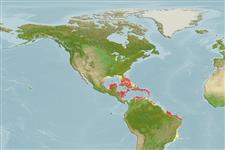>
Perciformes/Serranoidei (Groupers) >
Grammistidae (Soapfishes)
Etymology: Rypticus: Greek, ryptikos, -e, -on = easy to wash (Ref. 45335); carpenteri: Named for Michael Carpenter, station manager for the Smithsonian’s research station at Carrie
Bow Cay, Belize..
Environment: milieu / climate zone / depth range / distribution range
Sinh thái học
Biển Cùng sống ở rạn san hô; Mức độ sâu 0 - 40 m (Ref. 89885), usually 6 - 30 m (Ref. 89885). Tropical
Western Central Atlantic: Caribbean.
Bộ gần gũi / Khối lượng (Trọng lượng) / Age
Maturity: Lm ? range ? - ? cm
Max length : 8.6 cm SL con đực/không giới tính; (Ref. 89885)
Short description
Hình thái học | Sinh trắc học
Các tia vây lưng cứng (tổng cộng): 3 - 4; Các vây lưng mềm (tổng cộng): 24-26; Tia cứng vây hậu môn 1; Tia mềm vây hậu môn: 13 - 15. This species is distinguished from its congeners by the following unique set of characters: pectoral fin and distal portions of soft dorsal, caudal, and anal fins are pale yellow to yellow in life, pale in preservative; numerous dark spots on head and trunk, size of spots variable but those on head posterior to horizontal through center of orbit almost always smaller than pupil; interorbital region usually with 2 dark spots at posterior end, spots set slightly apart from orbital rim; belly with dark spots; caudal fin and sometimes soft dorsal and anal fins often with at least a few, sometimes tiny, dark spots; dorsal-fin spines 3 or 4 (almost always 4); total dorsal-fin elements modally 25; pectoral-fin rays modally 15; total caudal-fin rays modally 23; lower jaw extending anteriorly beyond upper jaw, mean difference between distance from tip of lower jaw to orbit and tip of upper jaw to orbit 5% head length (HL); relatively narrow caudal peduncle, average depth 11% SL (Ref. 89885).
Inhabits clear tropical , mean maximum depth of collected specimens was 17 m, only 6 specimens were collected at depths less than 5 m. This species lives among coral or rocks on steep slopes, vertical walls, or in other areas with large vertical relief, however, a few specimens have been taken among coral heads in shallow flat areas (Ref. 89885).
Life cycle and mating behavior
Chín muồi sinh dục | Sự tái sinh sản | Đẻ trứng | Các trứng | Sự sinh sản | Ấu trùng
Baldwin, C.C. and L.A. Weigt, 2012. A new species of soapfish (Teleostei: Serranidae: Rypticus), with redescription of R. subbifrenatus and comments on the use of DNA barcoding in systematic studies. Copeia 2012(1):23-36. (Ref. 89885)
IUCN Red List Status (Ref. 130435)
Threat to humans
Harmless
Human uses
Thêm thông tin
Age/SizeSự sinh trưởngLength-weightLength-lengthLength-frequenciesSinh trắc họcHình thái họcẤu trùngSự biến động ấu trùngBổ xungSự phong phúBRUVS
Các tài liệu tham khảoNuôi trồng thủy sảnTổng quan nuôi trồng thủy sảnCác giốngDi truyềnElectrophoresesDi sảnCác bệnhChế biếnNutrientsMass conversion
Các công cụ
Special reports
Download XML
Các nguồn internet
Estimates based on models
Preferred temperature (Ref.
123201): 25.4 - 28, mean 27.2 °C (based on 236 cells).
Phylogenetic diversity index (Ref.
82804): PD
50 = 0.5010 [Uniqueness, from 0.5 = low to 2.0 = high].
Bayesian length-weight: a=0.01000 (0.00244 - 0.04107), b=3.04 (2.81 - 3.27), in cm total length, based on all LWR estimates for this body shape (Ref.
93245).
Mức dinh dưỡng (Ref.
69278): 3.6 ±0.6 se; based on size and trophs of closest relatives
Fishing Vulnerability (Ref.
59153): Low vulnerability (10 of 100).
Nutrients (Ref.
124155): Calcium = 117 [60, 237] mg/100g; Iron = 0.811 [0.408, 1.472] mg/100g; Protein = 18.4 [16.6, 20.2] %; Omega3 = 0.198 [0.114, 0.341] g/100g; Selenium = 23.4 [11.4, 47.0] μg/100g; VitaminA = 180 [55, 627] μg/100g; Zinc = 1.67 [1.08, 2.52] mg/100g (wet weight);
